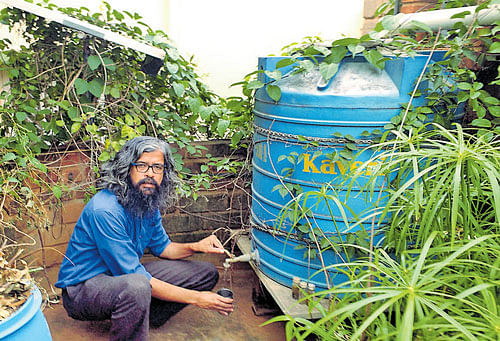
Heaps of garbage, endless traffic jams, increasing pollution and if these aren’t enough, another rude jolt that is waiting to hit Bengaluru is the water crisis. With groundwater depleting at a fast pace and the Cauvery water just not being adequate to meet the city’s needs, it has become imperative to save and conserve the existing sources through rainwater harvesting.
There are many Bengalureans, especially those who live in the outskirts of the city, who have adopted rainwater harvesting in their homes. Showing the way in implementing rainwater harvesting techniques at home is S Vishwanath, who has developed a quick, low cost and easy system of conserving water.
His wife Chitra Vishwanath, an architect, has also joined hands with him in promoting the concept. She helps people incorporate the basic rainwater harvesting measures in homes during the construction stage itself.
“Rainwater harvesting is not complicated. It’s a basic plumbing detail that must be looked into and sorted out at the construction stage. Houses with large spaces commonly use the rooftop method,” observes Chitra. Vishwanath pitches in,“We use the rainwater that we have collected for drinking and cooking purposes. This way we not only use good water but also save the extra expenditure related to water.”
Sandhya Mahesh has adopted rainwater harvesting methods in her home. She taps the rainwater with the help of rain chains that not only look attractive but are perfect decorative pieces for the garden. These chains serve the purpose of collecting every drop of water.
“We use rainwater for domestic purposes, including drinking. The sump is the common single storage for both rainwater as well as for the BWSSB. The storage capacity is around 8,000 litres. During good Monsoons, we get to collect water for about four to five months. This suffices for the daily consumption,” explains Sandhya.
Radhika Kumar, who lives near Sarjapur, never had to depend on groundwater, thanks to the rainwater that she has collected and stored over the last couple of years. “We have incorporated the basic rainwater harvesting methods in the design itself. Our rooftop has been built in such a way that the rainwater flows into a filtration system and collects in the sump. The bigger particles such as stones and mud are trapped in the filter,” she explains. Radhika adds that the fine dust too falls into the sump. “The sump has to be cleaned once or twice a year. We also have two overhead tanks, one exclusively for the storage of rainwater, and an additional one. If one tank is being cleaned, we have a backup,” she adds.
About the benefits of using rainwater, Radhika says, “The advantage is that one doesn’t have to use a softener because the water is already soft and also, the fixtures at home such as taps don’t get spoilt.”
About why people are slow in adopting rainwater harvesting in their homes, Chitra says, “People don’t worry about the water problem unless there is a reduction in the quality or quantity of water while some people simply don’t have an idea about the methods of conserving water,” she says.